![]()
![]()
![]()
Use LEFT and RIGHT arrow keys to navigate between flashcards;
Use UP and DOWN arrow keys to flip the card;
H to show hint;
A reads text to speech;
200 Cards in this Set
- Front
- Back
|
Sedimentary Rock
|
Those which consist of recycled rock material: wear or break it down, move it to lowland, deposit, lithify
|
|
|
Physical Weathering
|
cracks (aka joints) develop and grow until they are extensive enough to fully detach the rock into moveable blocks
|
|
|
Freeze Thaw Weathering
|
water retained in joints and fissures expands during freezing, acts as wedges
|
|
|
Roots Wedging
|
Trees rooting in joints, cracks, and fissures grow to diameters which force rock material apart
|
|
|
Salt Weathering
|
similar to root wedging, high temperature desert environments promote growth of salt crystals in pore spaces and fractures
|
|
|
Isolation Weathering
|
differential heating of rock surface expands outermost rock relative to interior, and cracks rock along grain boundaries
|
|
|
Wet-dry weathering
|
repeated cycles of heavy wetting then extended drying of (ex.) loosely lithified mudstone or shale can make joints in the rock, often rectiliniar
|
|
|
Spheroidal weathering
|
in sandstones, what begins with breakdown in cubic joints in sandstone becomes more spheriod with time, eventually having the appearance of skins or weathering rinds. Common in sandstones which have had concretionary lithification history
|
|
|
Exfoliation weathering
|
intrusive rocks develop convex sheet like texture, jointing follows concentric zoning of its cooling history (oblate-shaped intrusion cooling from outside in) as removal of overburden decreases pressure
|
|
|
Stress release weathering
|
similar to exfoliation, but for rock types other than intrusive. Removal of overburden reduces pressure, rock rebounds in layers or sheets
|
|
|
What are the three categories of weathering products
|
1. source rock residues
2. secondary minerals 3. soluble materials |
|
|
Source Rock Residues
|
the in-situ remains of jointed, cracked, or broken bedrock which retain (for the most part) the original composition
|
|
|
Secondary Minerals
|
Products of the weathering, after leached or dissolved (partly dissolved) components recombine with other elements to form crystalline additions to the rock detritus
|
|
|
Soluble Materials
|
Those water-borne ion-scale (solute) products of the weathering, which have been removed from the site of weathering. That is they are enroute to the nearest basin (somewhere in the river, lake, or an ocean system far from the weathering site)
|
|
|
Soils
|
Source rock residues which have been broken down, at least partly, to gravel-sized grains and which have experienced significant rainfall, plus incorporated some organic materials for are capable of growing vegetation
|
|
|
Erosion
|
the process of removing (ie transporting) material, usually from highland areas (source regions) to lowland areas (basins); in arid regions can happen just by wind alone
|
|
|
Proximal Deposit
|
material that is deposited close to its source
|
|
|
Distal Deposit
|
material which has traveled far before being deposited
|
|
|
What are the characteristics of a proximal deposit?
|
larger clasts, poor sorting and angular (non worn) faces/edges
|
|
|
What are the characteristics of a distal deposit?
|
finer grained, well sorted, tends to have a higher percentage of quartz grains making them compositionally mature
|
|
|
Compositionally Mature
|
A rock that contains a high percentage of quartz grains
|
|
|
Mud
|
The name you use in the field when you are unable to discern between silt or clay
|
|
|
Sorting
|
Grain distribution
|
|
|
What 3 things is sorting a function of?
|
1. input (was it like sized before?)
2. Transport medium (air vs water) 3. Distance traveled |
|
|
Poorly sorted
|
the rock contains grains spanning 3 or more of the grain size classes
|
|
|
moderately sorted
|
the rock contains grains spanning 2 of the grain size classes
|
|
|
well sorted
|
the rock consists entirely of grains within one grain size class
|
|
|
PHI (ᶲ)
|
An alternative measure of grain size which we use if we need a precise < statistically derived description for sorting
|
|
|
Grain Shape
|
The combination of form, roundness, and texture
|
|
|
Roundness
|
A description of grain edges (not overall shape) and reflects the degree to which transport of the grain has worn or torn off its formerly angular faces
|
|
|
What is the assumption we are making when determining roundness and what is the implication of this?
|
that weathering produces blocky or rectilinear grains the implication being that well rounded grain has traveled further or at a higher NRG then an angular grain
|
|
|
Surface Texture
|
a description of smoothness of the grain faces
|
|
|
Maturity
|
provides an estimate of how long material has been traveling from its source or “weathering” site to its point of deposition, it is a function of both texture (which is in large part dependent of wear during travel),and on composition
|
|
|
Arenite
|
composed mostly of quartz, making it compositionally mature
|
|
|
Arkose
|
composed of at least 25% feldspars, making it compositionally immature
|
|
|
Fabric
|
indicated the NRG level and type of transport medium that the sediment was deposited in
EX. a constantly moving stream will arrange the grains that line its bed according to the flow rate and flow depth |
|
|
Orientation
|
long-axis of a grain is usually parallel to the current (stream) direction
|
|
|
Imbrication
|
when grains pack with their long axis parallel to each other and with overlap, so that rows or planes interlock with each other
|
|
|
Porosity
|
the amount of pore space between grains → the better sorting the higher porosity
|
|
|
laminar
|
straight, unidirectional; a "solid stream"
|
|
|
What does the Hjulstrom Diagram illustrate
|
the minimum force (current velocity) required to move quartz grains on a planar bed at 1m water
|
|
|
What are the three categories of grain transport that entrained sediment flows downstream by?
|
1. Bedload
2. Suspended Load 3. Wash-Load |
|
|
Bed Load
|
(usually) coarse particles which travel along or very near to the river bed (ie stream bottom)
|
|
|
Traction
|
particles larger than sand-size which are in continuous traction with (ie sliding and shoving along) the stream bed
|
|
|
Saltation
|
grains “hop” along the river bottom, where”hop”means short-lived entrainment into the water column, to a height up to a few times their diameter
|
|
|
Suspended Load
|
(usually) finer material carried higher up in the water column, which remains in continuous suspension until water velocity falls significantly after which they are deposite
|
|
|
Intermittent Suspension
|
Occurs commonly for fine to medium grained sand, for which grains of sand may from time to time be dropped/re-entrained
|
|
|
Wash Load
|
(extra-fine material, clay) very low particle size results in very low settling velocity. can include material re-eroded from river bank, as well as chemically weathered source material
|
|
|
Basin
|
a standing body of water which acts as a sink for sediment (A lake, ocean). Water can not be moving unidirectionally on it, so a “pit” or low point in a river cannot be called a basin, these are called pools
|
|
|
Long System Sediment Transport
|
Materials that transport FAR→ALL the way down a river system to a basin a long distance away
|
|
|
Short System Sediment Transport
|
transport in which the basins are very near to (or immediately adjacent to) highland areas
|
|
|
What are 4 transport mechanisms?
|
1. Water (Fluvial)
2. Wind (Aeolian) 3. Ice (Glacial) 4. Mud (Alluvial) |
|
|
Colluvial
|
applies to the material moved by gravity. The unconsolidated (loose, non-lithified) material is called colluvium (or talus)
|
|
|
Alluvial
|
applies to the material moved en-masse by gravity with the aid of some water
|
|
|
Fluvial
|
applies to material entrained and carried entirely by water (streams), this is the dominant method of both short and long distance sediment travel
|
|
|
Glacial
|
deposits are those which are transported by ice and are dropped (deposited) when it melts
|
|
|
Coastal
|
deposits are those caused by wave action in large bodies of water (oceans, large lakes), this includes creation of beaches, reworking of beach sediments by prevailing currents (splits, bars, ect.)
|
|
|
Aeolian
|
deposits are moved by wind, gravity need not play a major role
|
|
|
Original Horizontality
|
means that deposition of sediment in water is done so in horizontal to sub-horizontal layers, each layer is called a bed
|
|
|
Superposition
|
refers to the intuitive concept that beds on the bottom of the stack were deposited first, therefore a stack of sedimentary beds youngs upwards
|
|
|
Ripple Marks
|
are indicative of wave action on the surface of the bed
Small ridges formed on the surface of sediment layer by moving water or wind, oriented perpendicular to the wave motion |
|
|
Cross Bedding
|
indicates prograde deposition of one seasonal (deltaic) or tidal (coastal) cycle
A feature of sandstone deposited on steep local slopes (ie large dunges), a series of thin, inclined layers within a larger bed of rock A feature of sand dunes, sand ridges deposited by ocean currents on the sea floor, sediment bars in river channels, and deltas |
|
|
Fossils and burrows
|
on or near the tops of bedforms
record biogenic activity of soft-bodied life which itself will not leave a fossil (no shell) identify the species, know the environment! |
|
|
Mud Cracks
|
indicate prolonged absence of water, sub-aerial setting
A shallow lake which dries up in the summer A desert environment that received a pulse of water |
|
|
Graded Bedding
|
systematic change in grain size from bottom to top
overload of sediment at depo-site early in event waning energy or current later = finer clasts at top typical of storm event or slope-failure (wet climate) event or turbidity current |
|
|
Marker Beds
|
Are those which contain something that permits correlation of units in time across a large distance
A coal seam, a specific short lived fossil, something with distinct coloration, an ash bed containing datable minerals from a volcanic eruption |
|
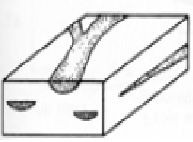
|
lenticular linear (shoestring)
|
|
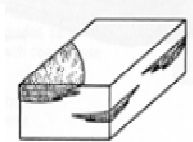
|
lenticular lobate (elliptical)
|
|
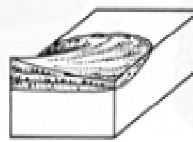
|
lobate wedge
|
|
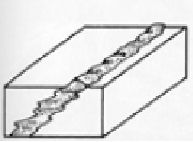
|
inclined sheet
|
|
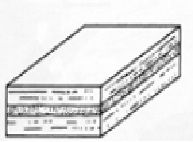
|
(flat) tabular sheet
|
|
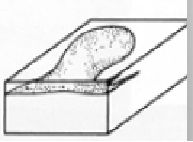
|
lobate to irregular sheet
|
|
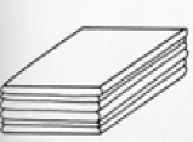
|
planar bedding
|
|
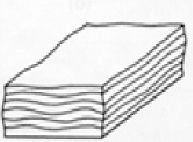
|
wavy bedding
|
|
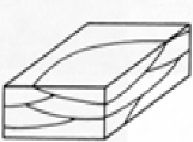
|
lenticular bedding
|
|
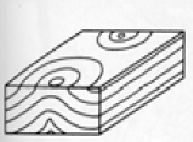
|
domal bedding
|
|
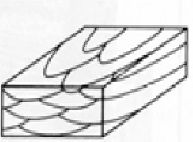
|
parabolic trough cross bedding (lenticular)
|
|
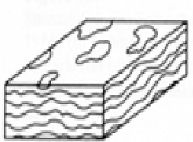
|
irregular (nodular) bedding
|
|

|
graded bedding
|
|
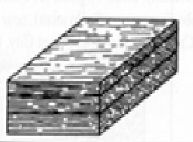
|
tabular planar cross bedding
|
|

|
convolute bedding
|
|
|
Diagenesis
|
the process by which the sediments are changed into rocks. The individual clasts or grains are bound to one another so that the deposited material behaves as a single unit
|
|
|
What are teh two steps of diagenesis? Describe them
|
1. Compaction
- weight compresses the sediments to push the grains into contact with one another - usually this occurs through addition of more material, sequential deposition 2. Cementation - Secondary minerals form along grain contacts and act as “glue” to bind the grains -- quartz and calcite are the most common cementing minerals -- hematite is also a good cement but is less common |
|
|
compositionally mature
|
rock composed mostly of quartz (arenite)
|
|
|
compositionally immature
|
contains at least 25% feldspars (arkose)
|
|
|
What are the 2 main categories of the composition of sedimentary rocks
|
1. siliclastic
2. chemical |
|
|
Limestone
|
consists of calcite, is the most common rock composition (either inorganic precipitate or bioclastic → shell remains, macro or microscopic)
|
|
|
Coal
|
composed of plant remains
|
|
|
Chert
|
is a siliceous rock (SiO2) which is actually a precipitate
|
|
|
What are the 4 root categories siliclastic (detrital) rocks fall into based on texture?
|
1. Breccia
2. Conglomerate 3. Sandstone 4. Mudstone |
|
|
Breccia
|
angular fragments
usually poor sorting and with immature matrix (v. proximal) largest fragment must exceed sand size |
|
|
Conglomerate
|
similar to breccia, except clasts have partly rounded to well-rounded faces/edges
rounding happens by mechanical wear during transport implies water-aided transport mechanism |
|
|
Sandstone
|
can not contain fragment larger than sand
compositional maturity viable |
|
|
mudstone
|
Fragments smaller than sand
Assign name based on largest size or fragment, such as, siltstone, or shale if discernable |
|
|
Major Minerals
|
>2% volume of the rock - quartz, feldspar, clay minerals
ex. average sandstone (sst) = 65% quartz, average shale = 50% quartz |
|
|
Accessory Minerals
|
< 2% volume of the rock - micas (biotite, more rarely muscovite), heavy minerals (ex. zircon, hornblende, garnet, apatite)
can break down into stable and unstable (table 5.1) to aid with assessment of maturity |
|
|
Rock Fragments
|
if present - grains that are not singular mineral crystals but rather represent a piece of intact former rock, however small
list in the rock description (but not the name) as rock type (sedimentary, igneous, metamorphic) |
|
|
What are 3 important cementing minerals
|
1. hematite
2. quartz 3. calcite |
|
|
What are the first and second most abundant sedimentary rock types
|
1. siliclastics
2. carbonates |
|
|
Limestone
|
calcite dominant mineral
|
|
|
dolostones
|
dolomite, in which Mg may replace for some or much of the Ca
|
|
|
Calcite
|
- Calcite Group
- Rhombohedral - CaCO3 - Dominant mineral of limestone, especially in rocks older then the tertiary |
|
|
Magnesite
|
- Calcite Group
- Rhombohedral - MgCO3 - Uncommon in sedimentary rocks but occurs in some evaporite deposits |
|
|
Rhondochrosite
|
- Calcite Group
- Rhombohedral - MnCO3 - Uncommon in sedimentary rocks, may occur in Mn-rich sediments associated with siderite and Fe-silicates |
|
|
Siderite
|
- Calcite Group
- Rhombohedral - FeCO3 - Occurs as cements and concentrations in shales and sandstones, common in ironstone deposits, also in carbonate rocks altered by Fe-bearing solutions |
|
|
Smithsorite
|
- Calcite Group
- Rhombohedral - ZnCO3 - Uncommon in sedimentary rocks, occur in association with Zn ores in limestones |
|
|
Dolomite
|
- Dolomite Group
- Rhomobohedral - CaMg(CO3)2 - Dominant mineral in dolomite, commonly associated with calcite or evaporite minerals |
|
|
Ankerite
|
- Dolomite Group
- Rhombohedral - Ca(Mg,Fe,Mn)(CO3)2 - Much less common then dolomite, occurs in Fe-rich sediments as disseminated grains or concentrations |
|
|
Aragonite
|
- Aragonite Group
- Orthorhombic - CaCO3 - Common mineral in recent carbonate sediments, alters readily to calcite |
|
|
Cerussite
|
- Aragonite group
- Orthorhombic - PbCO3 - Occurs in supergene lead ores |
|
|
Strontionite
|
- Aragonite group
- SrCO3 - Occurs in veins in some limestones |
|
|
Witherite
|
- Aragonite group
- Orthorhombic - BaCO3 - Occurs in veins associated with galena ore |
|
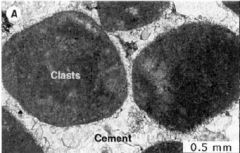
|
clasts in sparry calcite: intrasparite to intrasparudite
clasts might or might not be carbonate in chemistry, the dominant mineral in this case telling us of depositional environment (marine) = abundant sparry cement (note the lack of compaction) |
|
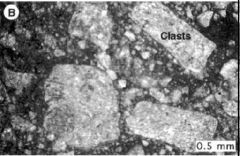
|
Clasts in sparry ccalcite: intrasparite to intrasparudite (relatively rare)
Increased packing and poorer sorting vs sparite |
|
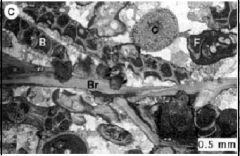
|
biosparite (fossils with sparite matrix)
A rock with fossil-content this high which was not microscopic in scale would be called a fossiliferous limestone |
|
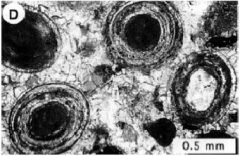
|
Oosparite (ooids in a sparry matrix)
ooids have radial zonation, form by rollin in calcium rich sediments |
|
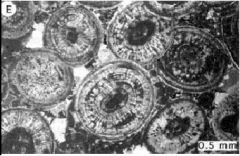
|
radial ooids in sparry calcite (white) and micrite (dark) cement
ooids have radial zonation, form by rollin in calcium rich sediments |
|

|
Pellets (peloid texture) in sparry calcite cement
Pellets = of the fecal variety, the bottom of your fish tank (in detail) 10 000 years later |
|
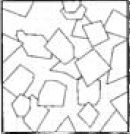
|
Planar Euhedral
- most dolomite crystals are euhedral rhombs, crystal-supported with intercrystalline areas filled with another mineral or unfilled (porus) |
|
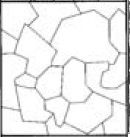
|
planar subhedral
- subhedral to anhedral dolomite crystals with low porosity and/or low intercrystalline matrix, straight compromise boundaries are common and many of the crystals have preserved crystal-face junctions |
|
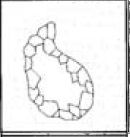
|
planar void-filling
- euhedral dolomite crystals lining large pores and vugs or surrounding patches of another mineral such as gypsum or calcite |
|
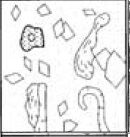
|
planar-porphyrotopic
- euhedral dolomite crystals floating in a limestone matrix, crystals are matrix supported |
|
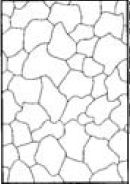
|
Nonplanar Anhedral
- Tightly packed anhedral dolomite crystals with mostly curved, oblate, serrated, indistinct, or otherwise irrgular intercrystalline boundaries, pre-crystal face junctions rare, crystals commonly have undulatory extinction |
|
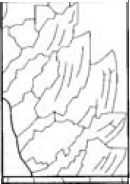
|
Nonplanar Void-filling
- Pore-lining, saddle-shaped, or baroque (irregular) dolomite crystals characterized by scimitar-like termination, as viewed in thin section, sweeping extinction |
|

|
Nonplanar-Porphytopic
- Single anhedral dolomite crystals or patches of anhedral dolomite crystals floating in a limestone matrix, crystals commonly have undulatory extinction |
|
|
What are the 3 stages of diagenesis
|
1. Eogenesis
2. Mesogenesis 3. telogenesis |
|
|
Eogenesis
|
BURIAL
- Organic reworking (bioturbation): destruction of primary sedimentary structures, formation of mottled bedding and other traces - Cementation and replacement: Formation of pyrite (reducing environment) or iron oxides (oxidizing environment), precipitation of quartz and feldspar overgrowths, carbonate cements, kaolinite, or chlorite |
|
|
Mesogenesis
|
BURIAL
- Physical Compaction: tighter grain packing, porosity reduction, and bed thinning - Chemical compaction (partial solution): precipitation of carbonate (calcite) and silica (quartz) cements with accompanying porosity reduction - Dissolution by Pore Fluids: Solution removal of carbonate cements and silica framework grains, creation of new (secondary) porosity by preferential destruction of less stable minerals - Mineral Replacement: Partial to complete replacement of some silicate grains and clay minerals by new minerals (ex. replacement of feldspars by calcite) - Clay mineral authigenesis: Alteration of one kind of clay mineral to another (ex. smectite to ilite or chlorite, kaolinite to ilite) |
|
|
Telogenesis
|
UPLIFT
- Dissolution, replacement, oxidation: solution of carbonate cements, alteration of feldspars to clay minerals, oxidation of iron carbonate minerals to iron oxides, oxidation of pyrite to gypsum, solution of less stable minerals (ex. pyroxenes, amphiboles) |
|
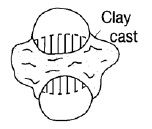
|
Plastic and Ductile Grain Deformation
- Combination of rigid and soft materials (sand grains in silt or clay) result in overall rearrangement of the softer material into all the void spaces |
|
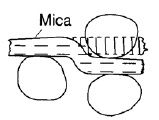
|
Flexible Grain Deformation
- A semi-rigid grain which was "roofing" a void space looses coherence, collapse into the former void space (settlement) |
|
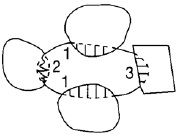
|
Pressure Solution
1. Concavo-convex contact 2. Sutured Contact 3. Long Contact - Contacts of grains where overpressured, release of Si and O2 ions which immediately reprecipitate in adjacent void-spaces (become cement) |
|
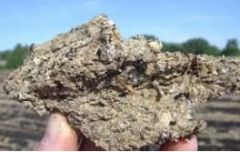
|
Marl
|
|

|
Coquina
|
|
|
What 3 carbonate rock names are detrital casts or shells of marine organisms for which diagenetic process is not similar to the bulk of carbonate rocks which are chemically precipitated?
|
1. Coquina
2. Chalk 3. Marl |
|
|
Coquina
|
An agglomeration of reasonably well sorted, partly abraded shell material
|
|
|
Chalk
|
Fine grained (well sorted) loosely consolidated (soft) material consisting of microorganic calcite "tests" (exoskeletons) such as foraminifers
|
|
|
Marl
|
A loosley consolidated fine-grained mixture of siliclastic and calcitic materials (clay and calcite)
|
|
|
Why are foraminifers useful?
|
rapid speciation results in short duration of cast type which in turn means very good for dating
|
|
|
Evaporites
|
an important group which produces, amongst other things, our major source for ingestible salts (halite) and crop fertilizer (potash)
|
|
|
Cherts
|
microcrystalline quartz, make up a relatively minor but important part of the sedimentary rock record (useful for paleocurrent/paleogeography)
|
|
|
Iron bearing sedimentary rocks
|
>15% Fe, small fraction of sed-rock record, but economically important as ores
|
|
|
Phosphorites
|
>15% P2O5 (=,> 6.5% P), limiting range, volumetrically minor
|
|
|
carbonaceous sedimentary rocks
|
coal, oil, oil-shales, bitumen
|
|
|
What are the three mineral classes that marine based precipitate minerals with form into?
|
1. Chlorides (mostly halite and sylvite)
2. Sulfates (mostly anhydrite and gypsum) 3. Carbonates (calcite and dolomite) |
|
|
Why do non-marine evaporite rocks precipitate different minerals then marine evaporites?
|
1. They are not yet in the “big sink of all time” (the ocean) that contains all chemically weathered material and/or atmospheric material that became absorbed into the hydrosphere
2. They can contain higher bicarbonate and/or higher magnesium 3. mostly, sparse to absent chlorine |
|
|
Coastal Sabkhas
|
are similarly broad and flat, to dune dominated regions adjacent or proximal to shorelines, but receive more saline water (different mineral assemblage)
|
|
|
Sabkhas
|
are salt flats, sub-aerial remains of broad flats (Ex. Utah)
|
|
|
Salinas
|
are shallow subaqueous environments
|
|
|
What are the two main categories of chert?
|
1. Bedded Cherts
2. Nodular Cherts |
|
|
What are the 4 categories bedded chert is divided up into?
|
divided based on types of organism
1. Diatomaceous 2. Radiolarian Chert 3. Spicularite (usually sponge parts) 4. skeletal-poor cherts |
|
|
What are the three types of phosphorite deposits?
|
1. Bedded
2. Bioclastic 3. Nodular |
|
|
What are the three graphical methods for presenting grain size data?
|
1. Histogram (grain size plotted against individual weight percent)
2. Frequency curve 3. Cumulative Curve (most useful of the three plots) |
|
|
Mode
|
diameter of the modal size corresponds to the diameter of grains represented by the steepest point on a cumulative curve
|
|
|
Median
|
Midpoint of the grain size distribution, half of grains by weight are larger and half smaller
|
|
|
Mean
|
arithmetic average of all particle sizes in the sample
|
|
|
Standard Deviation
|
mathematical expression of sorting
|
|
|
Skewness
|
asymmetry of the curve shape, reflects sorting in the "tails" of a grain size population
|
|
|
Kurtosis
|
Degree of peakedness, or the grain size frequencies various degree of sharpness or peakedness
|
|
|
What does Reynolds Number represent
|
the relationship of inertial forces (related to the scale and velocity of fluids in motion and tend to cause fluid turbulence)
|
|
|
Inertial Forces
|
related to the scale and velocity of fluids in motion and tend to cause fluid turbulence
|
|
|
Viscous Forces
|
increase with increasing viscosity of a fluid, resist deformation of a fluid and tend to suppress turbulence
|
|
|
Froude Number
|
Accounts for the addition of gravity influence, along viscosity and inertial forces. It is the ration between inertial and gravity forces
|
|
|
Boundary Layer
|
A zone of retardation where, fluid flow over a solid surface such as a streambed, flow in the immediate vicinity of the boundary is retarded by the frictional resistance of the boundary
|
|
|
Hydraulically Smooth
|
sediments on the stream bed are so small that they lie within the viscous sublayer, the near-bed flow is dominated by viscous forces
|
|
|
Hydraulically rough
|
grains are large enough that they exceed the thickness of the viscous sublayer and thus protrude into the turbulent part of flow
|
|
|
Critical Threshold
|
shear stress increases, larger grains are put into motion until finally grain motion is common everywhere on the bed. For grain movement is a direct function of several variables including boundary shear stress, fluid viscosity and particle size, shape and density. It is also an indirect function of the velocity of flow.
|
|
|
Drag Force
|
Acts parallel to the bed and is related to boundary shear stress
|
|
|
Alkali Feldspars
|
constitute a group of minerals in which chemical composition can range through complete solid solution series, potassium rich feldspars are common in this group
|
|
|
Plagioclase Feldspars
|
form a complex solid solution series ranging in composition from albite through anorthite, can be distinguished from alkali on basis of optical properties
|
|
|
Overgrowths
|
quartz cement that is chemically attached to the crystal lattice of existing quartz grains forming rims of cement
|
|
|
Compositional Maturity
|
refers to the relative abundance of stable and unstable framework grains in a sandstone (quartz=mature, feldspars or others=immature)
|
|
|
Textural Maturity
|
determined by the relative abundance of a matrix and the degree of rounding and sorting of framework grains, can range from immature (much clay, framework grains poorly sorted and poorly rounded) to supermature (little or no clay, framework grains well sorted and well rounded)
|
|
|
Quartz Arenites
|
Composed of more than 90% silicious grains
commonly white or light grey (may be stained by iron oxides) generally well lithified and well cemented typically occur in association with assemblages of rocks deposited in stable cratonic environments such as aeolian, beach, and shelf environments, therefore tend to be interbedded with shallow water carbonates most are texturally mature to super mature cross bedding particularly characteristic of these and ripple marks are moderately common rarely contain fossils |
|
|
Feldspathic Arenites
|
contain less than 90% quartz, more feldspar then unstable rock fragments, and minor amounts of other minerals such as mica and heavy minerals
some are colored pink or red because of presence of potassium feldspar or iron oxides, and others are grey to white Typically medium to coarse grained and may contain high percentages of subangular to angular grains Matrix content may range from trace amounts to more than 15% and sorting of framework grains can range from moderately well to poorly sorted commonly texturally immature or submature (they are wackes) Not characterized by any particular type of sedimentary structures bedding may range from essentially structureless to parallel laminated or cross laminated Fossils may be present, especially in marine beds typically occur in cratonic or stable shelf settings, where they may be associated with conglomerates, shallow water quartz arenites or lithic arenites, carbonate rocks, or evaporites Less commonly can occur in sedimentary successions that were deposited in unstable basins or other deep water, mobile belt settings commonly matrix rich (called feldspathic graywackes) |
|
|
Lithic Arenites
|
extremely diverse group of rock
characterized by generally high content of unstable rock fragments such as volcanic and metamorphic clasts contain less than 90% quartzose grains and more unstable rock fragments than feldspars colors may range from light grey (Salt and Pepper like) to uniform medium to dark grey many are poorly sorted, however the sorting ranges from well-poorly sorted generally poorly rounded tend to contain substantial amounts of matrix texturally immature to submature range from irregular bedding, laterally restricted, cross stratified fluvial units to evenly bedded laterally extensive, graded, marine turbidite units may occur in association with fluvial conglomerates and other fluvial deposits or in association with deeper water marine conglomerates, pelagic shales, cherts, and submarine basalts typically compositionally immature originate under conditions favoring the production and deposition of large volumes of relatively unstable materials may be deposited in non marine settings in proximal alluvial fans |
|
|
Volcaniclastic Sandstones
|
special type of lithic arenite composed primarily of volcanic detritus
may be made up largely of pyroclastic materials that have been transported and reworked or they may contain volcanic detritus derived from the weathering of old volcanic rocks characterized by the presence of euhedral feldspars, pumice fragments, glass shards, and volcanic rock fragments generally have very low quartz content |
|
|
Epiclastic Congomerates
|
which form by breakdown of older rocks through the process of weathering and erosion
|
|
|
Clast Supported Conglomerates
|
so rich in gravel-size framework grains that the gravel size grains touch and form a supporting framework
|
|
|
Matrix Supported Conglomerates
|
cast poor conglomerates that consist of sparse gravels supported in a mud/sand matrix
|
|
|
diamictites
|
matrix supported conglomerates
|
|
|
Quartzose (oligomict) conglomerate
|
tend to occur as thin, pebbly layers or lenses of pebbles in dominantly sandstone units
may be either clast or matrix supported most appear to be of fluvial origin |
|
|
Intraformational Conglomerates
|
composed of clasts of sediments believed to have formed within depositional basins
commonly form thin beds a few cms to a meter in thickness |
|
|
Rimmed Carbonate Shelves
|
Shallow platforms marked at their outer edges (margins) by a pronounced break in slope into deeper water
|
|
|
Unrimmed Platform
|
no pronounced marginal barrier
occur today on leeward side of large tropical banks and in all cool water carbonate settings |
|
|
Ramp Platform
|
a gently sloping unrimmed platform on which shallow-water deposits pass downslope with only a slight break in slope into deeper water facies
|
|
|
Isolated Platform
|
shallow water platforms tens to 100’s km wide
commonly located offshore from shallow continental shelves surrounded by deep water |
|
|
Epeiric Platform
|
no modern examples exist so we are only able to guess at the processes that form these, likely connected to the open sea and storms and winds may have strongly affected water circulation
|
|
|
what are the three major realms that diagenesis occurs at
|
1. Marine Realm
2. Meteoric Realm 3. Subsurface Realm |
|
|
Marine Realm
|
include the seafloor and the very shallow marine subsurface
characterized by seawater temperatures and marine waters of normal salinity principle diagenetic process in this environment involve bioturbation of sediments, modification of carbonate shells and other grains by boring organisms, and cementation of grains in warm water areas |
|
|
Meteoric Realm
|
may be brought from seafloor to here in 2 way: (1) by falling sea level and (2) by progressive sediment filling of a shallow carbonate basin
Characterized by presence of freshwater, it includes unsaturated vadose zone above the water table and the phreatic zone below the water table waters in this zone are typically highly charged with CO2 and thus are chemically acidic |
|
|
Subsurface Realm
|
after an initial period of diagenesis on the seafloor and possibly meteoric realm carbonate sediments are gradually buried and subjected to increased pressures, higher temps, and compositionally changed pore fluids
under these changed conditions carbonate sediments may undergo physical compaction, chemical compaction and additional chemical or mineralogical changes that may include dissolution, cementation, aragonite-to-calcite transformation and replacement of calcite by another mineral such as dolomite |
|
|
What are the 6 major diagenetic processes and changes
|
(1) Biogenic Alteration
(2) Cementation (3) Dissolution (4) Neomorphism (5) Replacment (6) Physical and Chemical Compaction |
|
|
Biogenic Alteration
|
organisms in carbonate depositional environments rework sediment by boring, burrowing, and sediment ingesting activities, these may destroy primary sedimentary structures in carbonate sediment and leave behind mottled bedding and various kinds of organic traces
|
|
|
neomorphism
|
covers the combined processes of inversion (ex. transformation of aragonite to calcite) and recrystallization
inversion refers to the change of one mineral to its polymorph strictly speaking inversion takes place only in the solid (dry) state may occur in all three realms but particularly important in meteoric and subsurface |
|
|
Replacement
|
involves the dissolution of one mineral and the nearly simultaneous precipitation of another mineral of different composition in its place
|
|
|
What are the 5 basic type of carbonate grains
|
1. carbonate clasts
2. skeletal particles 3. ooids 4. peloids 5. aggregate grains |
|
|
Extraclasts
|
Carbonate clasts that are derived from older limestone present in land sources located outside of the depositional basin
|
|
|
ooids
|
applied as a general name to coated carbonate grains that contain a nucleus of some kind ( a shell fragment, pellet, or quartz grain) surrounded by one or more thin layers or coatings consisting of fine calcite or aragonite crystals
|
|
|
micrite
|
microcrystalline calcite
|

